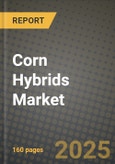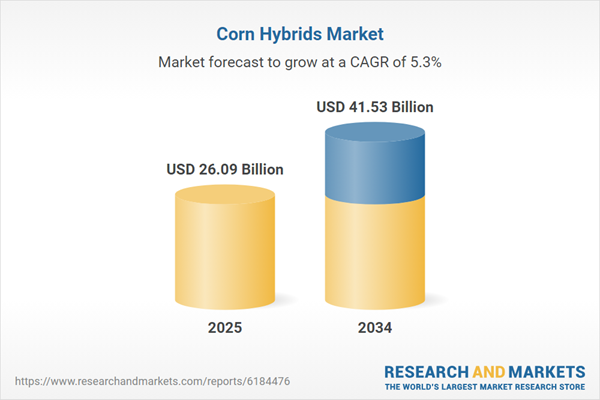Corn Hybrids Market
The corn hybrids market encompasses proprietary, cross-bred seed designed to deliver yield stability, standability, and grain quality across highly variable agronomic and climatic conditions. End-uses span food and feed grain, silage and forage for ruminants, starch and sweeteners, dry milling and snack processing, distillers’ ethanol, and emerging biobased materials. Product pipelines are moving from single-trait to stacked-trait hybrids - integrating herbicide tolerance, insect protection above/below ground, and increasingly drought/heat resilience - while short-stature corn, native trait optimization, and gene-edited lines expand the toolbox for lodging control and input efficiency. Breeding programs are accelerating via doubled haploids, genomic selection, and high-throughput phenotyping; seed coatings combine fungicide/insecticide protection with microbial consortia and biostimulants to enhance emergence under stress. Digital agronomy and precision planting tailor hybrid placement by soil zone, residue levels, and disease pressure, with variable-rate prescriptions and in-season nitrogen tools raising realized performance. Demand is supported by animal protein growth, ethanol blending mandates and octane strategies, modernization of feedlot/silage systems, and resilient food-grade channels. Competitive intensity is high among integrated seed-trait-chemistry majors and independent regional breeders; differentiation hinges on locally proven performance, trait stewardship, refuge compliance, grain quality specs (test weight, mycotoxin tolerance), and whole-farm ROI rather than plot-yield alone. Stewardship, export tolerances, and coexistence with non-GM/identity-preserved chains remain operational priorities, as do carbon-footprint reporting and regenerative practices (reduced tillage, cover crops) where hybrids that use water and nitrogen efficiently gain preference. Overall, value is migrating toward hybrids validated in multi-environment trials, paired with decision tools, and supported by robust agronomic service.Corn Hybrids Market Key Insights
- Multi-trait stacks are now table stakes
- Short-stature and lodging-resilient genetics
- Water-use and heat-tolerance as climate hedges
- Biological seed treatments and microbials
- Genomic selection and speed breeding
- Digital agronomy and hybrid-by-environment fit
- Grain quality and food-grade niches
- Silage and livestock integration
- Stewardship, coexistence, and market access
- Independent breeders vs integrated majors
Corn Hybrids Market Reginal Analysis
North America
Adoption centers on stacked traits for corn rootworm and broadleaf/grass control, with strong interest in short-stature and drought-resilient lines. Precision placement by soil management zone, plus fungicide and late-season nutrition strategies, is standard. Silage segments prioritize digestibility alongside standability. Retailers and independent agronomists influence hybrid choice, while stewardship for resistance management and export approvals guides trait selection.Europe
A patchwork of regulatory postures shapes portfolios, with non-GM conventional hybrids dominant and gene-edited prospects emerging where allowed. Breeding emphasizes early vigor, cold tolerance, and fusarium/microtoxin risk reduction for feed and food channels. Silage hybrids for dairy regions remain key, with emphasis on fiber quality and standability. Sustainability schemes encourage nitrogen efficiency and residue management. Local cooperatives and breeders with strong regional testing gain share.Asia-Pacific
Diverse environments - from temperate Northeast Asia to tropical South and Southeast Asia - drive segmented maturities and stress-tolerant genetics. Demand is supported by feed growth and rising mechanization. In India and parts of ASEAN, emphasis rests on drought/heat tolerance and disease packages, while China focuses on high-yield conventional and advancing trait approvals. Extension services and dealer education shape adoption; kernel quality matters for snack and starch processors.Middle East & Africa
Water scarcity and heat stress put a premium on hybrids with efficient transpiration and stable anthesis-silking intervals. South Africa’s commercial sector blends traited and conventional offerings; elsewhere, conventional drought-tolerant lines dominate. Silage demand grows with expanding dairy/feedlot infrastructure. Seed firms invest in localized testing, treated seed for early vigor, and distribution into smallholder networks through agro-dealers and NGOs.South & Central America
Brazil and Argentina adopt high-stack hybrids for pest and weed resistance across no-till systems, with increasing interest in heat/drought resilience and standability under high winds. Contracted corn for ethanol and livestock feed underpins steady demand. In Andean and Central American markets, earlier maturities and disease packages are critical. Dealer-led agronomy, second-crop (safrinha) positioning, and fungicide programs influence realized performance.Corn Hybrids Market Segmentation
By Type
- GMOs Seeds
- Non-GMOs Seeds
By Product
- Conventional Hybrids
- Non-Conventional hybrids
By Application
- Farmland
- Greenhouse
- Others
Key Market players
Bayer (DEKALB, Channel), Corteva Agriscience (Pioneer, Brevant), Syngenta Seeds (Golden Harvest, NK), KWS SAAT, Limagrain Group (LG Seeds), AgReliant Genetics (AgriGold, LG Seeds US), Beck’s Hybrids, WinField United (CROPLAN), Stine Seed, RAGT Semences, MAS Seeds, Advanta Seeds (UPL), Yuan Longping High-Tech, Shandong Denghai Seeds, Seed Co LimitedCorn Hybrids Market Analytics
The report employs rigorous tools, including Porter’s Five Forces, value chain mapping, and scenario-based modelling, to assess supply-demand dynamics. Cross-sector influences from parent, derived, and substitute markets are evaluated to identify risks and opportunities. Trade and pricing analytics provide an up-to-date view of international flows, including leading exporters, importers, and regional price trends.Macroeconomic indicators, policy frameworks such as carbon pricing and energy security strategies, and evolving consumer behaviour are considered in forecasting scenarios. Recent deal flows, partnerships, and technology innovations are incorporated to assess their impact on future market performance.
Corn Hybrids Market Competitive Intelligence
The competitive landscape is mapped through proprietary frameworks, profiling leading companies with details on business models, product portfolios, financial performance, and strategic initiatives. Key developments such as mergers & acquisitions, technology collaborations, investment inflows, and regional expansions are analyzed for their competitive impact. The report also identifies emerging players and innovative startups contributing to market disruption.Regional insights highlight the most promising investment destinations, regulatory landscapes, and evolving partnerships across energy and industrial corridors.
Countries Covered
- North America - Corn Hybrids market data and outlook to 2034
- United States
- Canada
- Mexico
- Europe - Corn Hybrids market data and outlook to 2034
- Germany
- United Kingdom
- France
- Italy
- Spain
- BeNeLux
- Russia
- Sweden
- Asia-Pacific - Corn Hybrids market data and outlook to 2034
- China
- Japan
- India
- South Korea
- Australia
- Indonesia
- Malaysia
- Vietnam
- Middle East and Africa - Corn Hybrids market data and outlook to 2034
- Saudi Arabia
- South Africa
- Iran
- UAE
- Egypt
- South and Central America - Corn Hybrids market data and outlook to 2034
- Brazil
- Argentina
- Chile
- Peru
Research Methodology
This study combines primary inputs from industry experts across the Corn Hybrids value chain with secondary data from associations, government publications, trade databases, and company disclosures. Proprietary modeling techniques, including data triangulation, statistical correlation, and scenario planning, are applied to deliver reliable market sizing and forecasting.Key Questions Addressed
- What is the current and forecast market size of the Corn Hybrids industry at global, regional, and country levels?
- Which types, applications, and technologies present the highest growth potential?
- How are supply chains adapting to geopolitical and economic shocks?
- What role do policy frameworks, trade flows, and sustainability targets play in shaping demand?
- Who are the leading players, and how are their strategies evolving in the face of global uncertainty?
- Which regional “hotspots” and customer segments will outpace the market, and what go-to-market and partnership models best support entry and expansion?
- Where are the most investable opportunities - across technology roadmaps, sustainability-linked innovation, and M&A - and what is the best segment to invest over the next 3-5 years?
Your Key Takeaways from the Corn Hybrids Market Report
- Global Corn Hybrids market size and growth projections (CAGR), 2024-2034
- Impact of Russia-Ukraine, Israel-Palestine, and Hamas conflicts on Corn Hybrids trade, costs, and supply chains
- Corn Hybrids market size, share, and outlook across 5 regions and 27 countries, 2023-2034
- Corn Hybrids market size, CAGR, and market share of key products, applications, and end-user verticals, 2023-2034
- Short- and long-term Corn Hybrids market trends, drivers, restraints, and opportunities
- Porter’s Five Forces analysis, technological developments, and Corn Hybrids supply chain analysis
- Corn Hybrids trade analysis, Corn Hybrids market price analysis, and Corn Hybrids supply/demand dynamics
- Profiles of 5 leading companies - overview, key strategies, financials, and products
- Latest Corn Hybrids market news and developments
Additional Support
With the purchase of this report, you will receive:- An updated PDF report and an MS Excel data workbook containing all market tables and figures for easy analysis.
- 7-day post-sale analyst support for clarifications and in-scope supplementary data, ensuring the deliverable aligns precisely with your requirements.
- Complimentary report update to incorporate the latest available data and the impact of recent market developments.
This product will be delivered within 1-3 business days.
Table of Contents
Companies Mentioned
- Bayer (DEKALB Channel)
- Corteva Agriscience (Pioneer Brevant)
- Syngenta Seeds (Golden Harvest NK)
- KWS SAAT
- Limagrain Group (LG Seeds)
- AgReliant Genetics (AgriGold LG Seeds US)
- Beck’s Hybrids
- WinField United (CROPLAN)
- Stine Seed
- RAGT Semences
- MAS Seeds
- Advanta Seeds (UPL)
- Yuan Longping High-Tech
- Shandong Denghai Seeds
- Seed Co Limited
Table Information
| Report Attribute | Details |
|---|---|
| No. of Pages | 160 |
| Published | November 2025 |
| Forecast Period | 2025 - 2034 |
| Estimated Market Value ( USD | $ 26.09 Billion |
| Forecasted Market Value ( USD | $ 41.53 Billion |
| Compound Annual Growth Rate | 5.3% |
| Regions Covered | Global |
| No. of Companies Mentioned | 15 |









